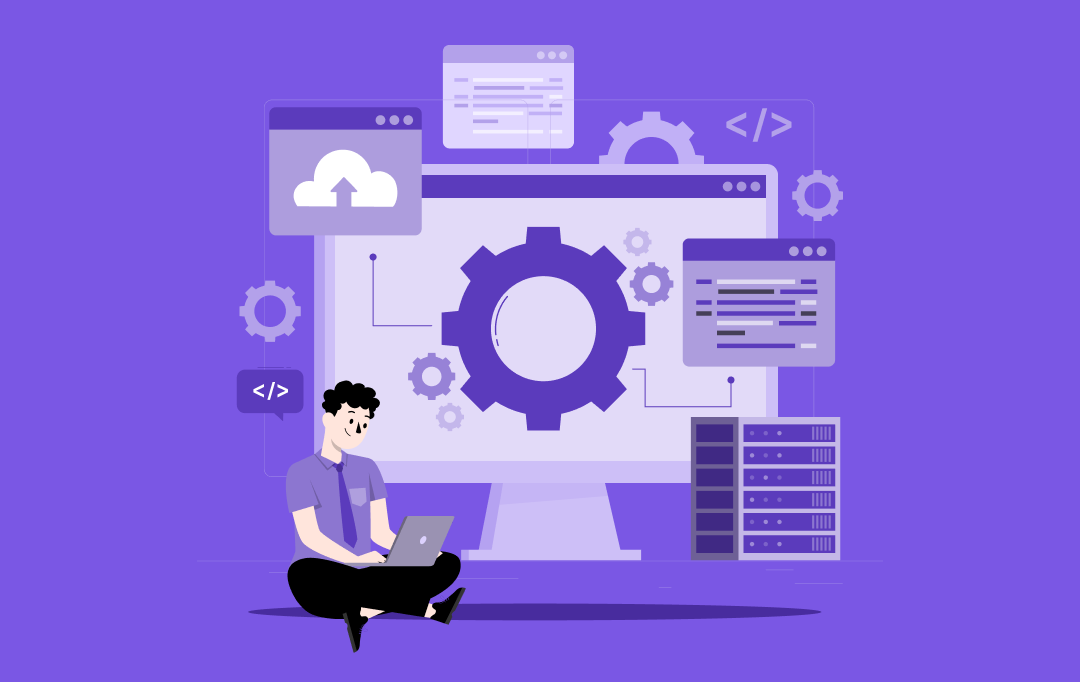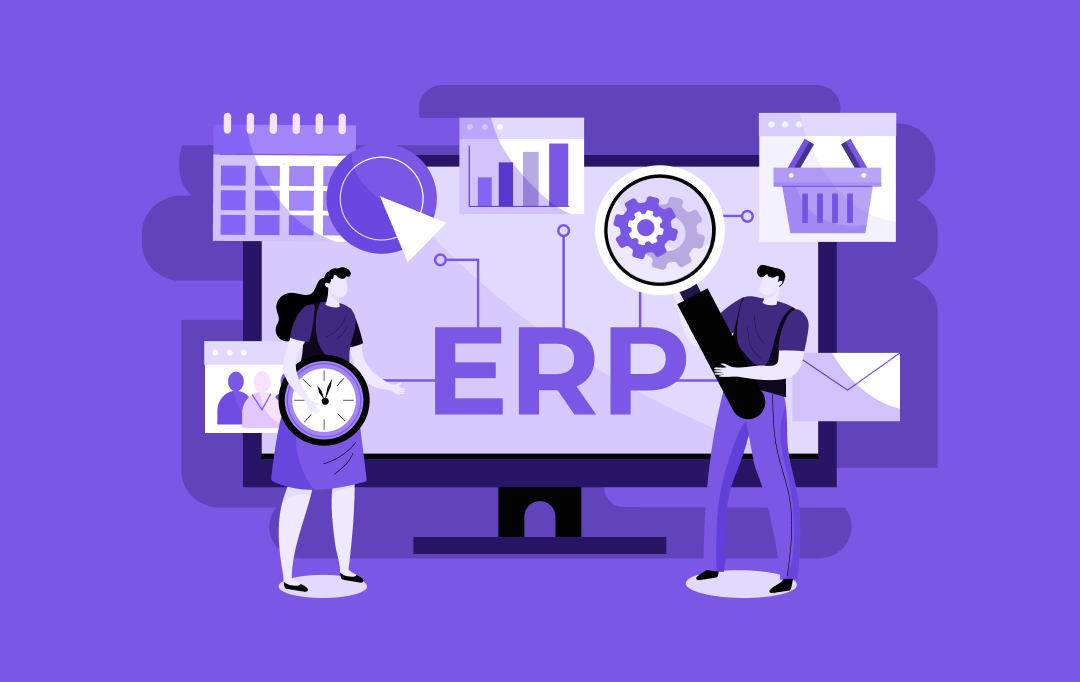The tournament industry has undergone a remarkable transformation over the years. Before the digital boom, organizing tournaments – whether for sports, eSports, or corporate events – was a logistical challenge. Event managers juggled between manual registrations, spreadsheets, paper scorecards, and on-site coordination. While these efforts delivered results, they often came with inefficiencies, errors, and scalability issues.
Enter digitalization. With the advent of technology, tournament management shifted to software-based solutions, bringing automation and efficiency to the forefront. However, even within this evolution, businesses often faced the dilemma of building custom tournament software from scratch, an expensive and time-consuming venture, or relying on generic solutions that lacked the flexibility to align with their brand identity and unique requirements.
This is where white-label tournament software development stepped in as a game-changer. Offering a balance between customization and affordability, white-label solutions allow businesses to deploy fully branded tournament platforms without the heavy lifting of development. They’ve become especially popular in eSports, recreational sports, and event management, enabling entrepreneurs to tap into emerging markets while saving time and resources quickly.
However, one question often arises for businesses looking to change the space: How much does it cost to develop white-label tournament software?
Let’s talk numbers; the cost to build white-label tournament software can vary from $50,000 to over $300,000. But why such a wide range? It all comes down to the scope and scale of your project.
This article dives deep into the factors influencing costs, the benefits of these solutions, and the features of white-label tournament software that can elevate your platform to a competitive edge. Whether you’re looking to cater to niche gaming communities or manage large-scale sporting events, understanding these aspects will guide you in making informed decisions.
How Much Does It Cost to Build White-Label Tournament Software?
The white-label tournament software cost depends on several factors, including the level of complexity, the technology stack, and the development team’s expertise. Broadly, the cost can be categorized into simple, mid-range, and complex solutions. Let’s look into them in detail.
Costs by Complexity Levels
The White-label tournament software cost depends largely on its complexity. Basic solutions with essential features can cost less, while advanced or custom solutions demand higher investments due to extensive functionality and scalability.
Simple
Simple white-label tournament software typically covers the basics. It includes foundational features like user registration, tournament brackets, and basic scoring systems. These solutions are ideal for startups or entrepreneurs testing the waters in smaller markets.
| With limited customization options and a relatively straightforward tournament software development process, the costs generally range from $15,000 to $30,000, and the development timelines for simple solutions usually span around 2 to 4 months. |
Mid-Range
Mid-range software is the go-to choice for businesses targeting larger audiences or seeking more robust solutions. These solutions often support multiple tournament formats, payment integrations, and better scalability. Mid-range development typically requires additional resources for enhanced backend functionality and a polished user interface.
| The custom white-label software cost for such products ranges between $40,000 and $70,000, depending on the level of customization and the team’s hourly rates. Development timelines for these projects average 4 to 6 months. |
Complex
Complex white-label tournament software caters to enterprises or platforms aiming for a competitive edge in the market. These solutions often integrate advanced features like AI-based matchmaking, real-time analytics, cross-platform compatibility, and multi-language support. Additionally, they might require high-end security protocols to protect sensitive data.
| The cost to build white-label tournament software in complex categories can start at $100,000 and go up to $250,000 or more. Development timelines can extend to 8 months or longer, especially when incorporating cutting-edge technology. |
Typically, costs are calculated by multiplying the hours expected for each task by the development team’s hourly rate plus any additional fees for materials and miscellaneous expenses.
Costs by Development Stages
The cost to build white-label tournament software is divided into multiple stages, each contributing to the overall cost. From planning to post-launch maintenance, every stage has distinct tasks and expenses.
| Development Stage |
Description |
Estimated Cost ($) |
Planning
|
Requirement analysis, feasibility studies |
5,000 – 10,000 |
Design
|
Wireframes, user interface (UI) design |
10,000 – 20,000 |
Development
|
Coding, backend integration, feature implementation |
50,000 – 150,000 |
Launch
|
Deployment, testing, bug fixes |
10,000 – 30,000 |
Maintenance
|
Updates, support, scaling |
10,000 – 20,000 annually |
Quick Formula: Estimate the Cost of White-label Tournament Software
Estimating the white-label tournament software cost involves analyzing team size, complexity, and development hours. Understanding the required features and technical resources helps calculate an approximate budget.
Total Cost to Develop a White-label tournament software = (Number of Hours×Hourly Rate)+Cost of Materials+Miscellaneous Expenses
For Example: Total Cost= ($100×1,000hours) = $100,000
Factors Affecting the Cost of Tournament Software
Several factors influence the white-label tournament software development cost, and understanding these factors helps businesses better plan and allocate resources for their development projects. While these tiers would have given you a general idea, the final cost will also depend on factors like:
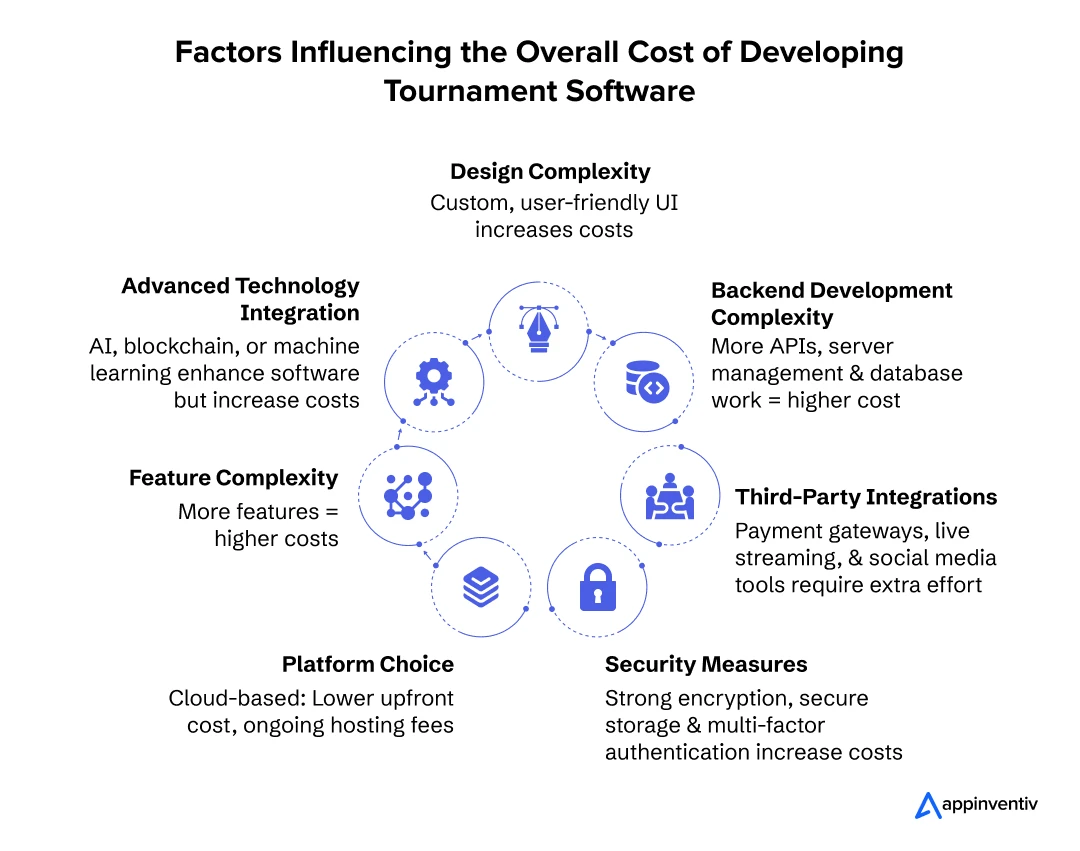
Design Complexity
The complexity of the software’s design plays a key role in determining its cost. A custom, user-friendly, and responsive interface demands more design effort and expertise, which increases the tournament software cost. On the other hand, simpler designs or using templates can keep costs lower but may compromise on branding and user experience.
Backend Development Complexity
A major cost factor is building the backend infrastructure for white-label tournament software, which involves API developments, managing servers, and ensuring efficient database operations. More complex backend systems require more development time, resources, and testing to ensure scalability, reliability, and smooth data flow.
Third-Party Integrations
Integrating third-party services, such as payment gateway integration, live streaming platforms, sports data providers, social media platforms, and other communication tools, adds to the overall white-label tournament software development cost. These integrations require additional development effort, licensing, and testing to ensure smooth and secure functionality, contributing to higher development expenses.
Security Measures
Since tournament software handles sensitive data, implementing strong security measures is essential. Data encryption, secure storage, multi-factor authentication, and regular security updates increase the complexity and white-label tournament software costs as higher security standards require advanced tools and expertise.
Platform Choice
The selection of cloud-based or on-premises platforms greatly influences the tournament software development cost. Cloud-based solutions typically offer scalability and easier maintenance but may involve ongoing hosting fees. On-premises solutions, while providing more control, tend to be more expensive due to the need for infrastructure and maintenance.
Feature Complexity
The number and complexity of features in the white-label tournament software directly affect the development cost. Advanced features such as detailed reporting, employee engagement tools, and benefits management demand more development time and specialized expertise, driving up the overall cost of building the software.
Advanced Technology Integration
Advanced technologies like:
- Artificial intelligence (AI)
- Machine Learning
- Blockchain
- Internet of Things
can elevate the functionalities and features of white-label tournament software. However, their integration requires specialized skills, tools, and infrastructure, significantly increasing the development cost and timeline.
Hidden Costs of Developing a White-Label Tournament Software
Beyond the initial development expenses, maintaining and scaling a white-label tournament platform comes with additional costs that businesses must anticipate. Overlooking these hidden costs can lead to budget overruns, impacting the long-term viability of the software. Here are some key expenses to consider:
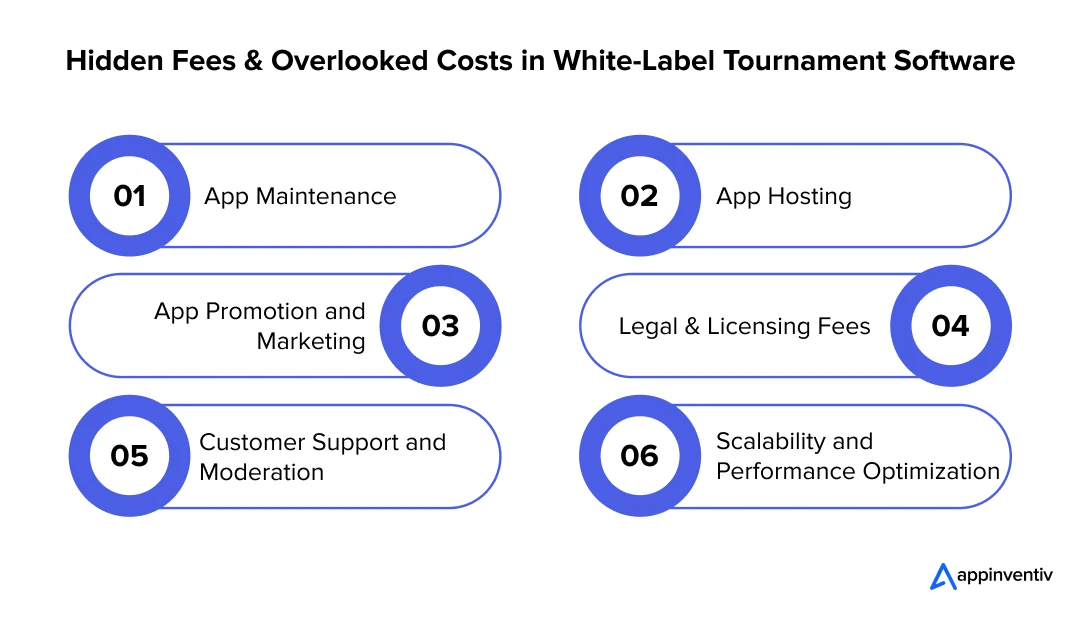
App Maintenance
Once the tournament software is live, continuous maintenance will be required to ensure smooth performance. However, regular updates for security patches, bug fixes, feature enhancements, and compliance with evolving industry standards add to ongoing costs. On average, businesses should allocate 15-20% of the initial development cost annually for maintenance.
App Hosting
Tournament software requires reliable hosting for real-time user interactions, live streaming, and data storage. Although cloud-based solutions like AWS, Google Cloud, or Azure provide scalable hosting, their costs are high based on storage, bandwidth, and server uptime. As user traffic increases, so do hosting expenses, so choosing a plan that balances performance and cost is essential.
App Promotion and Marketing
Building a great tournament platform is the first step; attracting users is equally important. Marketing expenses, including paid advertising, influencer partnerships, SEO optimization, and community engagement, can add massively to the overall cost. Social media campaigns, email marketing, and tournament sponsorships can further drive adoption but require a well-planned budget.
Legal and Licensing Fees
Depending on the region and type of tournaments hosted, legal fees may be required for compliance with data privacy laws, intellectual property rights, and broadcasting rights. Additionally, if the software includes payment processing, compliance with financial regulations like PCI DSS is necessary, adding to licensing and legal costs.
Customer Support and Moderation
A tournament platform needs ongoing user support to address technical issues, disputes, and general inquiries. Hiring a dedicated support team or implementing AI-driven chatbots incurs additional expenses. Also, if the platform includes community-driven tournaments, content moderation may be required to ensure fair play and compliance with guidelines.
Scalability and Performance Optimization
As the user base grows, additional investment in performance optimization becomes necessary. Ensuring the platform can handle peak tournament traffic without lag or crashes through load balancing, database optimization, and security enhancements requires ongoing development efforts that ultimately demand financial planning.
By accounting for these hidden costs early in the development process, you can avoid financial surprises and ensure that the tournament software remains competitive and sustainable in the long run.
Must-Have Features of White-Label Tournament Software
In today’s competitive tournament landscape, software must go beyond basic functionality; it should deliver an efficient, scalable, and engaging experience for organizers, participants, and audiences. White-label tournament platforms should be designed to provide a comprehensive suite of tools that simplify operations while enabling seamless customization – something that becomes possible with the amalgamation of the best tournament software features.
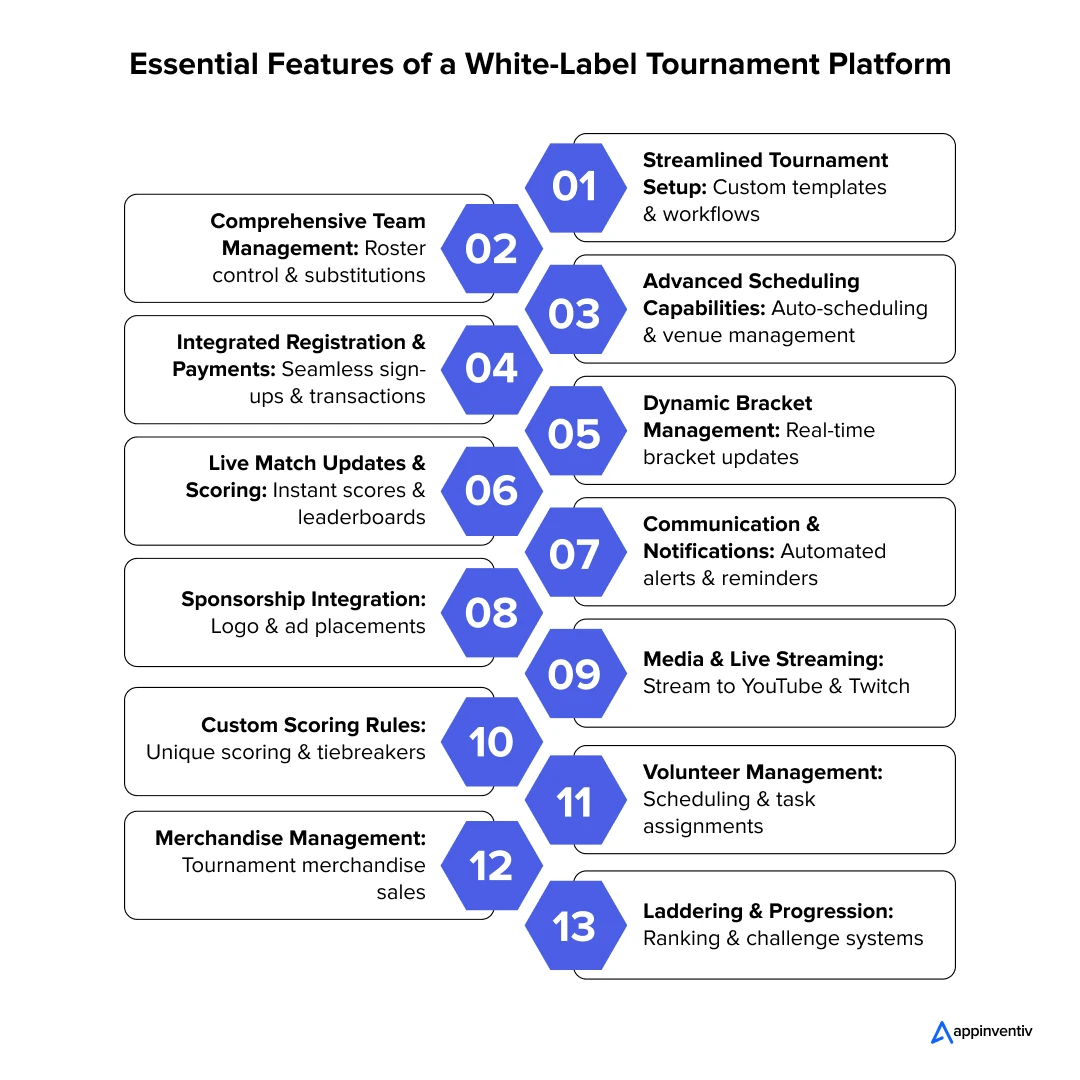
Streamlined Tournament Setup
Effective software simplifies the complexities of tournament planning. Organizations can create events tailored to their unique requirements with customizable templates and automated workflows. From single-elimination rounds to complex ladder systems, the set of features of the white-label tournament software platform ensures an efficient setup process, saving time and effort.
Comprehensive Team Management
Managing team logistics is central to tournament success. Advanced tools allow organizers to monitor player rosters, approve substitutions, and facilitate direct communication with team captains. These features ensure smooth coordination and foster a structured competitive environment.
Advanced Scheduling Capabilities
Scheduling matches efficiently is crucial to maintaining momentum during tournaments. White-label solutions automate this process, determining player availability, venue constraints, and event timelines. The result is a conflict-free, optimized schedule that minimizes delays and ensures seamless progression.
Integrated Registration and Secure Payment Gateways
A smooth registration process sets the foundation for participant satisfaction. White-label software simplifies sign-ups with intuitive forms and integrated payment systems. Additionally, secure gateways can support various payment methods, providing participants with a hassle-free onboarding experience.
Dynamic Bracket Management
Real-time bracket tracking is essential for both transparency and engagement. Interactive brackets update automatically as results come in, offering a clear visual overview of tournament progress. This set of white-label tournament software features supports various formats, including knockout stages and ladder systems, ensuring flexibility for diverse event types.
Real-Time Match Updates and Live-Scoring
Accurate, real-time score updates keep participants and audiences engaged. Integrated live scoring systems provide instant updates, while leaderboards reflect results immediately. When you build tournament software with this level of precision, it not only enhances the viewing experience but also reinforces credibility and trust.
Robust Communication and Notification Systems
Clear communication underpins every successful tournament. Built-in messaging tools and automated notifications keep players, teams, and staff informed of critical updates, such as schedule changes or match results. This ensures seamless coordination and minimizes disruptions.
Integrated Sponsorship Management
Maximizing sponsorship opportunities is a priority for many organizers. White-label tournament software development should provide tools to incorporate sponsor logos, promotional banners, and branded content within the software, offering a professional and seamless way to boost visibility for partners.
Media Integration and Live Streaming
Reaching a wider audience is a key goal for modern tournaments. With built-in live-streaming capabilities, events can be broadcast across platforms like YouTube or Twitch. This enhances audience engagement and provides additional exposure for sponsors and stakeholders.
Customizable Scoring Rules
Every tournament has its unique scoring system, and the software should reflect this flexibility. White-label solutions enable organizers to define custom scoring rules, penalties, and tiebreaker criteria, ensuring a fair and consistent approach that aligns with the event’s objectives.
Efficient Volunteer Management
Large tournaments often rely on volunteers to handle operational tasks. White-label platforms streamline volunteer coordination by providing tools for task assignments, scheduling, and real-time tracking. This ensures smooth operations and better event execution.
Merchandise Management Solutions
Offering branded merchandise is an effective way to enhance the event experience while generating additional revenue. With inventory tracking and order management features, the software simplifies the logistics of handling tournament-themed gear.
Laddering and Competitor Progression
Ladder systems are a hallmark of competitive tournaments, fostering engagement through structured progression. The software allows players to challenge higher-ranked opponents and advance based on performance, creating a fair and competitive environment that keeps participants motivated.
By understanding and integrating these features influencing tournament software pricing into a unified platform, white-label tournament software delivers efficiency, scalability, and engagement for all stakeholders. From local leagues to large-scale championships, these functionalities empower organizers to execute events with precision and professionalism.
Tips to Optimize the White-Label Tournament Software Development Cost
Building high-quality white-label tournament software doesn’t have to come with an overwhelming price tag. By making strategic choices in development, businesses can control costs while ensuring they get a robust and scalable solution. Here are some key ways to optimize development expenses:
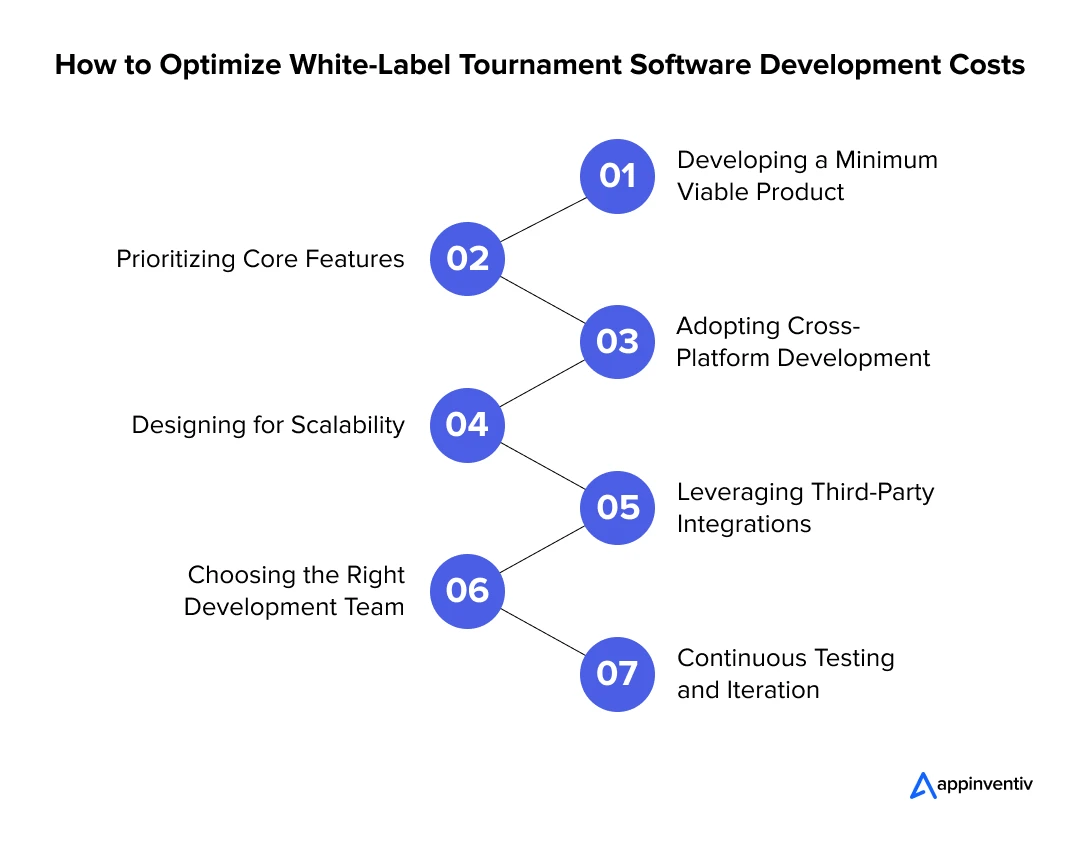
Developing a Minimum Viable Product
Instead of building a feature-heavy tournament platform, focus on launching a Minimum Viable Product (MVP) with essential functionalities like registration, bracket management, and match scheduling. This approach allows you to test the software, gather user feedback, and iterate without incurring unnecessary costs on complex features that may not be needed initially.
Prioritizing Core Features
It’s easy to get carried away with advanced functionalities, but adding too many features early on can significantly drive up costs. Prioritizing core features directly impacts tournament management and user experience and helps streamline development. Additional functionalities like AI-driven matchmaking, sponsorship management, or analytics can be integrated in later phases as the platform scales.
Adopting Cross-Platform Development
Suppose your tournament software is intended for both web and mobile. In that case, choosing cross-platform frameworks like Flutter or React Native can significantly cut costs compared to building separate native applications for iOS and Android. This approach reduces development time and simplifies maintenance and future updates.
Designing for Scalability
A well-structured, scalable architecture ensures that the software can handle the increased load without costly redevelopment as the number of users and tournaments grows. Cloud-based solutions, microservices architecture, and modular development help reduce future scaling expenses while maintaining performance.
Leveraging Third-Party Integrations
Instead of developing every feature from scratch, integrating third-party APIs for payments, live streaming, and notifications can reduce development costs and time. Services like Stripe (for payments), Twilio (for messaging), and AWS (for hosting) provide reliable solutions at a fraction of the cost of custom-built alternatives.
Choosing the Right Development Team
Development costs vary significantly based on location. Hiring an experienced team in cost-effective regions like India or Eastern Europe can provide high-quality results at a lower price than hiring developers in the U.S. or Western Europe. Working with an agile development team also ensures flexibility, reducing expenses tied to major reworks or delays.
Continuous Testing and Iteration
Regular testing during development prevents costly fixes later. Adopting automated testing methods and running beta tests before full deployment can help identify issues early, saving time and money in the long run.
By following these cost-optimization strategies, businesses can build a high-performing, scalable white-label tournament platform without exceeding their budget.
Designing Impeccable Tournament Software
The design of tournament software goes beyond aesthetics; it lays the groundwork for a smooth and engaging experience for everyone involved. From players and organizers to spectators, the platform’s design should balance functionality, ease of use, and visual appeal. Here’s how to approach designing when you build tournament software.
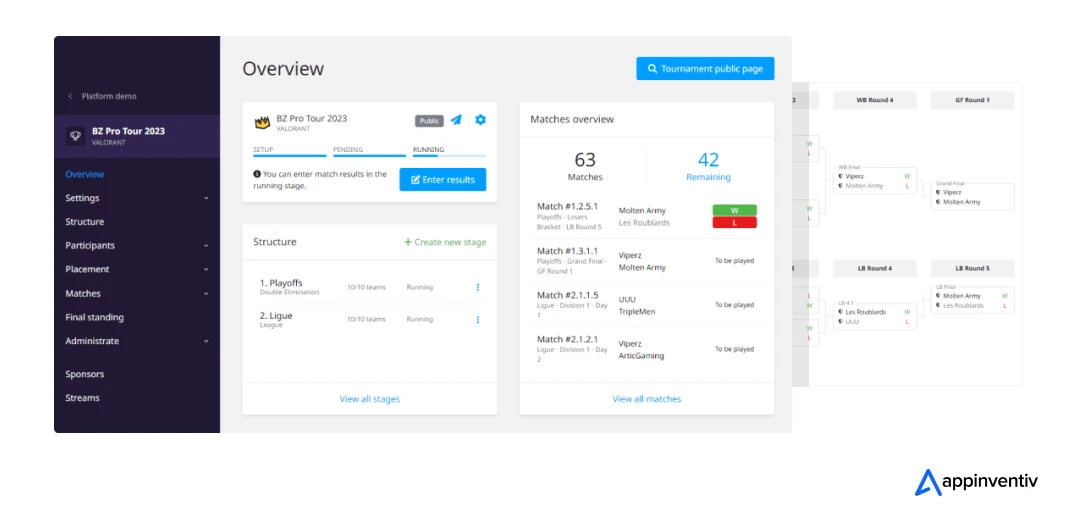
Focus on User-Centric Experiences
A user-first design approach would enhance the software’s overall functionality and thus form the most critical part of tournament software development. Features like registration forms, team management dashboards, and tournament brackets should be intuitive and easy to navigate. The goal, ultimately, is to ensure that users spend less time figuring out how the platform works and more time engaging with the event.
Adopt a Responsive Design Framework
Since users will access the software on devices ranging from desktops to smartphones, adopting a responsive design would make the platform adaptable to various screen sizes. Whether users track live scores on their phones or manage matches on a tablet, the experience should remain seamless.
Streamline Organizer Workflows
Organizers often juggle multiple responsibilities during tournaments. When you build tournament software, an intuitive dashboard with tools like drag-and-drop scheduling and automated notifications would simplify their tasks and help maintain smooth event operations.
Offer Customization for Branding
Providing customization options, such as the ability to add logos, adjust color schemes, or modify layouts, would empower organizers to align the software with their event’s branding. This flexibility ensures the platform feels tailored to their unique needs.
Blend Visual Appeal with Practicality
While a visually appealing interface is important, practicality should not be compromised. Features like dynamic leaderboards and bracket views, designed with simplicity in mind, would engage users while maintaining clarity and usability while influencing the cost to develop a white-label tournament software.
Simplify Complex Functionalities
Even advanced features, such as sponsorship integration or live scoring, should be designed for ease of use. Breaking these functionalities into manageable steps would help users navigate them without feeling overwhelmed.
Incorporate Accessibility Features
To cater to a diverse audience, the design should accommodate users with varying needs. Accessibility features like screen reader compatibility, keyboard navigation, and high-contrast modes would create a more inclusive experience.
Add Engaging Visual and Interactive Elements
Features like live-streaming integration, real-time match highlights, and interactive brackets would excite players and spectators alike. Thoughtful placement of these elements across the interface would ensure they complement the overall user experience without creating visual clutter.
By focusing on user needs, responsiveness, and performance, tournament software can become a powerful tool that enhances event organization and participation. While it directly contributes to the cost of build white-label tournament software, a carefully crafted design would streamline processes and create a memorable experience for everyone involved.
Choosing the Right Tech Stack for White-Label Tournament Software
The technology stack forms the backbone of any tournament software, determining its performance, scalability, and adaptability. While the specific stack may vary based on requirements, here’s a look at common technologies used in developing white-label tournament platforms:

The selection of these technologies would depend on the scope and scale of the software, with an emphasis on building a robust, reliable, and user-friendly platform. A carefully curated tech stack ensures the software remains scalable and future-proof, but only when the tournament software development process is well streamlined.
Development Process for White-Label Tournament Software
The development process of white-label tournament software involves several stages, from initial planning to final deployment. The complexity of the software directly influences the time and cost required, making it crucial to adopt a structured approach. Agile methodology for tournament software development helps manage costs efficiently while delivering a flexible and scalable solution. Here’s a breakdown of the typical development process:
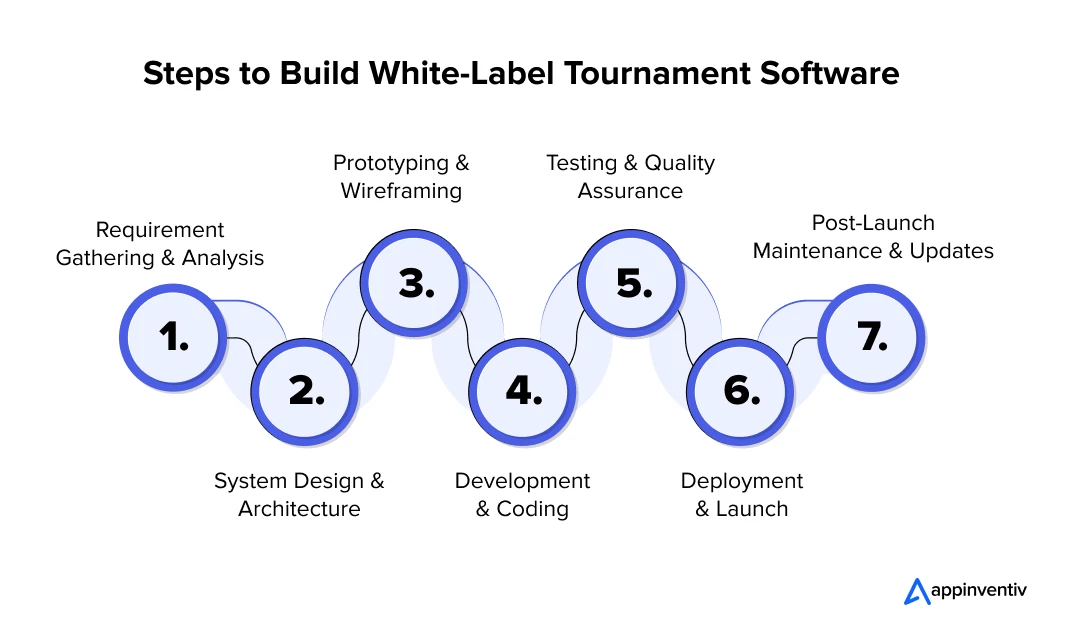
Requirement Gathering & Analysis
The first step is to identify the key requirements of the software, including the features and functionalities that will be included. This stage helps set clear expectations for both the development team and stakeholders. Understanding the intricacies of the project upfront ensures that the scope is well-defined, which ultimately controls costs.
System Design & Architecture
Once the requirements are clear, the next step is to design the software architecture. This includes database schema, API structures, and the tech stack to be used. Detailed design considerations may be necessary for more complex systems, increasing the time and cost. Here, making strategic decisions about scalability is essential, ensuring the system can handle future growth.
Also Read: How to Choose the Best Software Architecture
Prototyping & Wireframing
Creating wireframes and prototypes allows developers and stakeholders to visualize the software’s layout and user interface. This step helps identify potential usability issues early on, reducing the need for costly design revisions later. Prototypes also help gain early feedback and make adjustments before development begins.
Development & Coding
During this stage, developers start coding the application based on the specifications. The coding phase can become time-consuming and resource-intensive with complex functionalities, such as real-time match updates, payment integrations, and media streaming. Devops and Agile work seamlessly; thus, adopting an agile approach is easy and quick. The agile approach breaks development into smaller, manageable sprints and enables teams to focus on one feature at a time, ensuring consistent progress while keeping costs in check.
Testing & Quality Assurance
Testing is crucial to ensure the software is bug-free and functions as expected across all devices. Manual and automated testing is performed at different stages of development, with quality assurance teams validating the code against predefined requirements. The more complex the software, the longer the testing phase may take, potentially driving up costs.
Deployment & Launch
After the software passes testing, it is deployed to production servers. Depending on the platform’s scalability, this process can require significant resources to ensure a smooth rollout. With agile methodology, features can be rolled out iteratively, allowing the software to launch earlier and with minimal risk.
Post-Launch Maintenance & Updates
Even after the software is launched, it requires ongoing support and updates. Agile methodology lends itself well to this stage, allowing teams to continuously improve the software based on user feedback and market changes. Regular updates and feature additions are easier to manage with agile processes, ensuring the platform evolves in line with user expectations.
The development process for white-label tournament software requires a structured team to manage each phase effectively. From planning to deployment, each stage demands specific expertise, and the complexity of the software determines the team size and composition. The structure also plays a pivotal role in deciding the cost of custom tournament software.
Team Structure for White-Label Tournament Software Development
Building a successful white-label tournament software requires a team with specialized skills across various roles. Below is an outline of the key roles typically needed in the development team and the number of resources we usually allocate to each.
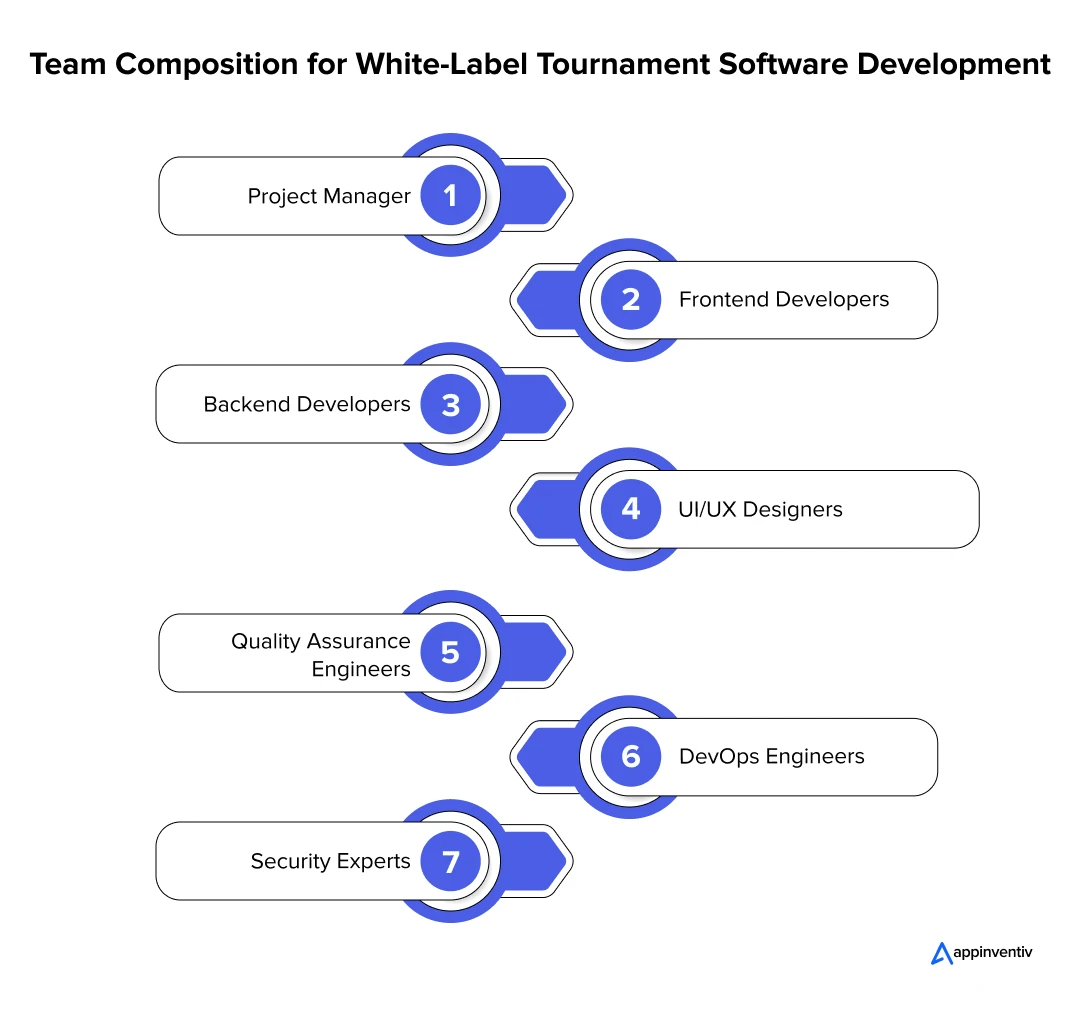
Project Manager (1): The project manager oversees the development process, ensuring the project is completed on time, within budget, and aligned with client requirements.
Frontend Developers (2-3): Frontend developers focus on creating the user interface and experience, developing the elements that users directly interact with, such as forms, dashboards, and live score displays.
Backend Developers (3-4): Backend developers handle the server-side functionality, including database management, APIs, match scheduling algorithms, and integrating payment processing systems.
Also Read: Cost to Hire Software Developers – A Complete Guide
UI/UX Designers (1-2): UI/UX designers ensure the software is visually appealing and user-friendly, optimizing user navigation and overall layout for ease of use.
Quality Assurance Engineers (1-2): QA engineers test the software to identify bugs, check performance, and ensure the platform runs smoothly and meets user expectations.
DevOps Engineers (1): DevOps engineers manage the deployment and server-side operations, ensuring the software is scalable, secure, and ready for high-traffic events.
Security Experts (1): Security experts focus on safeguarding user data by implementing security protocols such as encryption, authentication, and other measures to prevent cyber threats.
While the difference in cost to build white-label tournament software is substantial, businesses also need to consider factors like time zone differences, communication barriers, and project management style when choosing between the two regions. However, with agile methodologies, the challenges of working with remote teams can be effectively managed.
With the right team in place, including developers, designers, and project managers, you’ll be well-equipped to identify gaps in the market and capitalize on opportunities. By focusing on areas like customization, mobile optimization, and data analytics, your team can deliver a unique product that fills the needs of tournament organizers, setting your platform up for success in a crowded market.
Gaining an Edge in the Tournament Software Market
While major players like Challonge, Toornament, and Battlefy dominate the tournament software market, there are still opportunities for new entrants to distinguish themselves by addressing current gaps and evolving user needs.
- Customization: Many existing platforms offer basic solutions with limited flexibility. By providing more customizable features, such as tailored branding, unique scoring systems, and adaptable tournament formats, new players can meet the specific needs of diverse event organizers.
- Simplified User Experience: Existing platforms often overwhelm users with complex features. Offering a streamlined, intuitive design focused on ease of navigation and setup could appeal to organizers who want efficiency without the complexity.
- Mobile Optimization: While many platforms have mobile apps, the user experience is often lacking. By enhancing mobile features like real-time notifications, live scoring, and easy access to tournament details, new software can cater to users who need to manage events on the go.
- Integration Capabilities: Existing platforms often overlook seamless integration with CRM systems, social media, and marketing tools. By offering these integrations, new players can provide a more efficient, time-saving solution for tournament organizers.
- Affordability: Many established platforms can be costly, especially for smaller leagues or organizations. Offering a more affordable solution without sacrificing essential features could make your platform attractive to a broader range of customers.
- Niche Markets: Focusing on emerging sports or non-traditional events, like retro gaming or tabletop tournaments, could help fill the gaps left by mainstream platforms. Catering to these niche markets offers new entrants the chance to tap into underserved audiences.
- Data Analytics: While many platforms track scores, offering in-depth data analytics on player performance, audience engagement, and tournament success can provide valuable insights. This would help tournament organizers make informed decisions and improve future events.
By addressing these key areas: customization, user experience, mobile optimization, integration, affordability, niche markets, and data analytics, new players can effectively differentiate themselves and fill the gaps in the tournament software space.
Appinventiv: Your Tech Partner to Develop White-Label Tournament Software
At Appinventiv, we specialize in creating robust, white-label software development services that cater to the diverse needs of event organizers. Whether you’re managing a sports tournament, esports competition, or other competitive events, our team can help you build a platform that delivers exceptional experiences for participants and audiences.
We always focus on providing flexible, scalable tournament software that can grow with your event. From registration and payment systems to advanced features like live scoring, real-time updates, and bracket management, we ensure your platform has everything needed to manage a smooth and engaging tournament experience. We also offer white-label solutions that allow you to fully brand and customize the software to reflect your event’s unique identity.
Appinventiv’s experience developing tournament solutions means we understand the nuances of running successful events. We help optimize your platform to be user-friendly, ensuring a seamless experience for organizers and participants. Our solutions are designed to integrate with other tools you may already use, enhancing your tournament’s capabilities and improving overall efficiency.
Whether launching a single event or planning long-term growth, our team can support your journey with ongoing updates, maintenance, and enhancements to ensure your software remains relevant and capable of meeting evolving demands.
If you are a startup or a well-established enterprise looking for a competitive advantage, Appinventive is the right partner for you. The compliance expertise backed by the testimonials of happy clients proves their dedication to creating high-performance and future-proof tournament software.
By partnering with Appinventiv, you gain a trusted ally in the tournament software space, one that will help you stand out and create a platform that both tournament organizers and participants will trust and enjoy using.
FAQs
Q. How much does white-label tournament software cost?
A. The white-label tournament software cost can vary significantly based on several factors, such as the complexity of features, the scale of the tournament, and the development team’s location.
- Generally, prices for a basic white-label tournament software solution start at around $20,000 – $50,000.
- For mid-range solutions with advanced features such as live scoring, custom brackets, and payment integrations, the cost can range from $50,000 to $100,000.
- Highly complex, feature-rich platforms could exceed $100,000.
Additional ongoing support, maintenance, and updates costs should also be factored in.
Q. How long does it take to build tournament software?
A. The development timeline for tournament software depends on the complexity of the project and the resources available. For a simple white-label solution, the development process can take anywhere from 3 to 6 months.
The timeline could extend to 6 to 12 months or more for more advanced platforms with customized features and integrations. It’s important to allocate enough time for thorough testing and iterations to ensure the software meets your requirements.
Q. What is white-label tournament software?
A. White-label tournament software is a pre-built solution that can be fully branded and customized to match the needs of a specific event or tournament organizer. It allows businesses to provide their unique tournament platform without developing the software from scratch. The solution is typically flexible, offering a range of features like registration, scheduling, brackets, live scoring, and participant communication, all while allowing for full branding and rebranding to fit the organizer’s identity.
Q. How much does it cost to maintain tournament software?
A. The cost of maintaining tournament software typically involves ongoing expenses for bug fixes, updates, security patches, and technical support. On average, the annual maintenance cost can range from 15% to 20% of the initial development cost. For example, if the initial software development costs $50,000, the annual maintenance fee would be around $7,500 to $10,000. Additional costs may arise if there are significant feature upgrades or scaling requirements as your tournaments grow.
Product Development & Engineering
IT Managed & Outsourcing
Consulting Services
Data Services
Didn't find what you're looking for? Let us know your needs, and we'll tailor a solution just for you.




